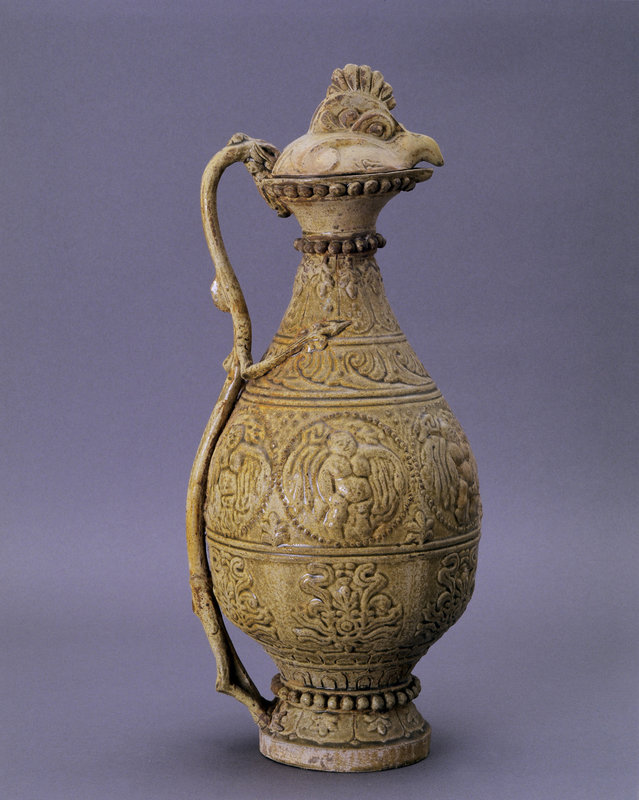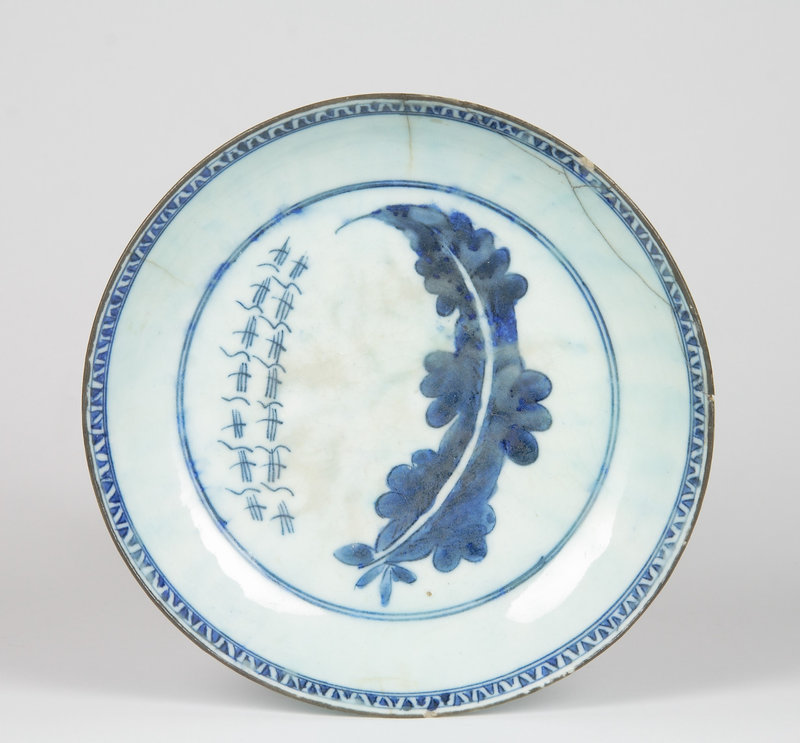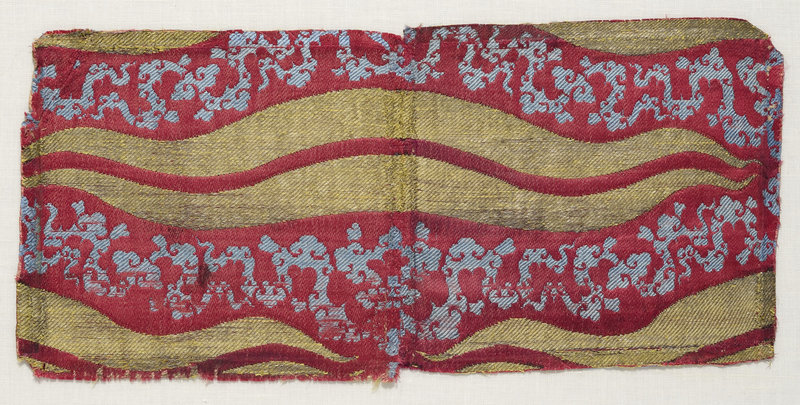'Liquid Frontiers and Entangled Worlds' at the MAO Museo d'Arte Orientale, Turin
Stranger with veiled face funerary statuette (?) Shaanxi male character, Tang Dynasty, 7th - first half 8th century CE (?). Beige earthenware with gray engobe, white engobe (or pigment) and colored pigments. MAO Museum of Oriental Art, Turin
TURIN - The third chapter of the series of exhibition Liquid Frontiers and Entangled Worlds, Trad u/I zionid'Eurasia is part of a composite research programme taking place at MAO between 2023 and 2024 which seeks to analyse the artistic trajectories and cultural dynamics that have characterised exchange between Asia and Europe over the centuries.
Trad u/I zioni d'Eurasia highlights the critical role of Asia and the Mediterranean as a fulcrum of cross-cultural interaction and as site of connection, negotiation and constant re-emergence.
The Exhibition Trad u/I zioni d'Eurasia explores the concepts of cultural translation, transposition and interpretation through a selection of objects from West, Central and East Asia. These objects raise questions about material and immaterial circulation, ways of transforming meaning and use between Asia and Europe across two thousand years of history.
Investigating the migration of ideas, forms, techniques and symbols in an open, inclusive dialogue, the show highlights the osmotic reciprocity between continents and seas, and creates new narratives for visual and material culture that are specific and relative rather than universalising and generic.
The scientific approach also reflects the sensory perception of materiality: the way these objects were perceived and desired for their visual allure and unique chromatic effects – gold and blue in particular – or for their reflecting, gleaming or transparent surfaces.
Far from wanting to be exhaustive, the objects selected that offer alternatives to the euro-centric paradigm of artistic excellence- They reassert the critical role played by Central Asia in the global transmission of ideas and creation. The Mediterranean Sea played a pivotal role in this cross-cultural phenomenon, as an intermediate space and creator of boundaries but also as a phenomenal catalyst of exploration and contact: a liquid frontier where continents converge and artistic expressions and cultural phenomena are constantly reinvented.
The exhibition is divided into thematic sections with a special focus on colour – blue, red and gold – and materiality – ceramics, fabrics, metalworkd, paper and pigments.
Visitors will admire splendid silks from the ancient region of Sogdiana, in Central Asia, blue and white ceramics produced between the Persian Gulf and China, a refined selection of Tartar Clothes made of silk and gold in the thirteenth century during the Mongol period between Iran and China, that were prized by the European mediaeval aristocracy and the clergy, rare examples of tiraz (Egypt, tenth century), textiles embroidered with inscriptions highlighting the importance of calligraphy in the Islamic world, and a series of zoomorphic metal incense burners (Iran, ninth–thirteenth centuries), reaffirming the centrality of essences in Mediaeval Islamic societies.
The project draws on numerous loans from major Italian collections and institutions, reflecting the presence in Italy of a shared multicultural history: alongside objects from Central Asia in the MAO collection there will be rarely seen textiles, ceramics and miniatures from the Fondazione Bruschettini per l'Arte Islamica e Asiatica, Khorassan metalwork from the Aron Collectionand important loans from the Museo Internazionale delle Ceramiche, Faenza, the church of San Domenico, Perugia, the Museo delle Civiltà di Roma, the Galleria Sabauda - Musei Reali and the Palazzo Madama, Turin.
Understood as an organic platform for study and research, the exhibition will gradually transform over one year through the rotation of some of the works on display and the introduction of new themes and sensorial stimuli, such as new commissions and installations by contemporary artists. It will also be enriched by a series of talks and a public program of music and performances.
In addition, as has become customary at MAO and widely appreciated by the public, a booklet with in-depth articles on the main subjects of the exhibition will be distributed free of charge.With texts by the curatorial team and contributions from Yuka Kadoi, Maria Ludovica Rosati and Mohammad Salemy, this publication is an indispensable tool to better understand the content of the exhibition.
As with MAO's previous exhibitions, Trad u/I zioni d'Eurasia privileges the dialogue between ancient objects and contemporary works.
Transnational artist Yto Barrada (Franco-Moroccan, born in Paris in 1971) will be 'subverting' the traditional museum approach. Her site-specific installation will gradually develop over the course of a year, offering new reflections on the colour and materiality of the works on view, inspired by the volume Color Problems: A Practical Manual for the Lay Student of Color by Emily Noyes Vanderpoel (1842—1939). Published in the early twentieth century, the book delves into the relationship of colours combinations derived from objects like Assyrian tiles, Persian rugs, an Egyptian mummy case and even a teacup and saucer.
Yto Barrada's project is a joint-collaboration with the Fondazione Merz, where the artist will hold a solo exhibition in the autumn of 2024.
Yto Barrada is the winner of the Fourth Mario Merz Prize, a biennial award instituted in 2013 with the aim of identifying and supporting individuals in the fields of international contemporary art and music.
The project draws on numerous loans from major Italian collections and institutions, reflecting the presence in Italy of a shared multicultural history: alongside objects from Central Asia in the MAO collection there will be rarely seen textiles, ceramics and miniatures from the Fondazione Bruschettini per l'Arte Islamica e Asiatica, Khorassan metalwork from the Aron Collectionand important loans from the Museo Internazionale delle Ceramiche, Faenza, the church of San Domenico, Perugia, the Museo delle Civiltà di Roma, the Galleria Sabauda - Musei Reali and the Palazzo Madama, Turin.
Understood as an organic platform for study and research, the exhibition will gradually transform over one year through the rotation of some of the works on display and the introduction of new themes and sensorial stimuli, such as new commissions and installations by contemporary artists. It will also be enriched by a series of talks and a public program of music and performances.
In addition, as has become customary at MAO and widely appreciated by the public, a booklet with in-depth articles on the main subjects of the exhibition will be distributed free of charge.With texts by the curatorial team and contributions from Yuka Kadoi, Maria Ludovica Rosati and Mohammad Salemy, this publication is an indispensable tool to better understand the content of the exhibition.
As with MAO's previous exhibitions, Trad u/I zioni d'Eurasia privileges the dialogue between ancient objects and contemporary works.
Transnational artist Yto Barrada (Franco-Moroccan, born in Paris in 1971) will be 'subverting' the traditional museum approach. Her site-specific installation will gradually develop over the course of a year, offering new reflections on the colour and materiality of the works on view, inspired by the volume Color Problems: A Practical Manual for the Lay Student of Color by Emily Noyes Vanderpoel (1842—1939). Published in the early twentieth century, the book delves into the relationship of colours combinations derived from objects like Assyrian tiles, Persian rugs, an Egyptian mummy case and even a teacup and saucer.
Yto Barrada's project is a joint-collaboration with the Fondazione Merz, where the artist will hold a solo exhibition in the autumn of 2024.
Yto Barrada is the winner of the Fourth Mario Merz Prize, a biennial award instituted in 2013 with the aim of identifying and supporting individuals in the fields of international contemporary art and music.
The exhibition will also include the works MOSADEGH (2023) by the Iranian artist Shadi Harouni, who uses the written word to connect the history of her country with the universal experience of loss, repression, healing and social activism, and the immersive installation Shimmering Mirage (Black)(2018) by renowed artis Anila Quayyum Agha.
Trad u/I zioni d'Eurasia is the third chapter in the exhibition series Liquid Frontiers and Entangled Worlds, which opens MAO's Islamic Art Gallery and permanent collection to new interpretive directions through other collections and curatorial influences, both local and international. Since 2023, the following exhibitions have been organised: Lustre and Luxury from Islamic Spain, curated by Filiz Çakır Phillip and in collaboration with the Fondazione Bruschettini per l'Arte Islamica e Asiatica – from 19 January to 4 June – and Sovereign Metals. Festivities, the Hunt and the Firmament in Medieval Islam, curated by Veronica Prestini and in collaboration with The Aron Collection – from 14 June to 12 November 2023.
'Liquid Frontiers and Entangled Worlds, Two Thousand Years of Visual and Material Culture between the Mediterranean and East Asia', MAO Museo d'Arte Orientale, Turin - October 5, 2023 – September 1,2024
Ewer with rooster's head, Iran, Kashan, 13th century (or late 12th - early 13th century?). Siliceous impasto, openwork decoration, motifs in black under turquoise glaze. MAO Museum of Oriental Art, Turin.
Ewer with phoenix head lid, China, Sui dynasty, early 7th century. White-grey porcelain stoneware made by mold with the addition of lathe-worked and freehand elements, covered with green-yellow glaze. MAO Museum of Oriental Art, Turin.
Pitcher with phoenix head, Tang Dynasty, first half 8th century, Northern China, Henan, Gongxian kilns. Beige-white earthenware with lead glazes. MAO Museum of Oriental Art, Turin
Ewer with rooster's head, Iran, Kashan, 13th century. "Frit" body, lustre decoration on white opaque glaze. MAO Museum of Oriental Art, Turin.
Rooster-head jug, Iran, Kashan or Sultanabad, 13th century. "Frit" body, decoration in black under turquoise glaze with touches of blue. Traces of gold leaf. MAO Museum of Oriental Art, Turin.
Dish with the name of the craftsman Khalid, Iraq, 9th - 10th century. Clay body, calligraphic decoration in cobalt blue and green on opaque white glaze bearing the name of the calligrapher-decorator Khalid. MAO Museum of Oriental Art, Turin.
Feline-shaped incense burner, Iran, 12th-13th century. Cast, pierced, engraved and ageminated bronze in silver. The Aron Collection.
Pilgrim's flask, Iran, 13th-14th century. Unglazed clay earthenware with mold decoration. MAO Museum of Oriental Art, Turin.
"Moon-flask", Ming Dynasty, Yongle Reign, 1403-1424, China, Jingdezhen; Porcelain painted in cobalt blue underglaze with geometric and plant motifs. Palazzo Madama - Museo Civico d'Arte Antica, Turin.
Dish with calligraphic decoration in Chinese taste, Iran, 17th century. Siliceous faience with blue glazed painted decoration. MIC, International Museum of Ceramics in Faenza.
Dish with decoration of extreme oriental taste, Iran, Safavid period, 17th century. Glazed pottery (siliceous impasto), blue and black paint. Museum of Civilizations, Rome.
Folio from the Shahnama (Book of Kings), 'The coronation of Kay Kavus sitting cross-legged on throne', Persia, Muzaffarid (Shiraz?), Circa 1340. Ink, matte watercolor and gold on paper. Bruschettini Foundation for Islamic and Asian Art, Genoa, Italy.
Textile fragment with winged lions within rooks and griffins, Central Asia, Mid-13th century. Silk and lamé gold lampas. Bruschettini Foundation for Islamic and Asian Art, Genoa, Italy.
Dish with three bunches of grapes, Turkey, Iznik, Circa 1530-35. Siliceous impasto ceramic, with cobalt blue decoration and turquoise touches painted on white engobe and under transparent glaze. Bruschettini Foundation for Islamic and Asian Art, Genoa, Italy.
Textile fragment with cintamani motif and clouds, Turkey, Istanbul, Second half 16th century. Silk and gold lampas (kemha). Bruschettini Foundation for Islamic and Asian Art, Genoa, Italy.
Anila Quayyhum Agha, Shimmering Mirage, Weight of Black: Jule Collins Smith Museum of Fine Art, Auburn, AL, 2021. Lacquered steel and halogen bulb, 48" x 48" x 48", 2019. Photo by Mike Cortez

/https%3A%2F%2Fprofilepics.canalblog.com%2Fprofilepics%2F1%2F0%2F100183.jpg)
/https%3A%2F%2Fstorage.canalblog.com%2F03%2F02%2F119589%2F96711876_o.jpg)
/https%3A%2F%2Fstorage.canalblog.com%2F11%2F31%2F119589%2F94773502_o.jpg)
/https%3A%2F%2Fstorage.canalblog.com%2F20%2F83%2F119589%2F94772815_o.jpg)
/https%3A%2F%2Fstorage.canalblog.com%2F26%2F72%2F119589%2F75604929_o.jpg)
/https%3A%2F%2Fstorage.canalblog.com%2F59%2F60%2F119589%2F26458628_o.jpg)



















/image%2F1371349%2F20240315%2Fob_244543_433273530-1633376087432404-55342065241.jpg)
/http%3A%2F%2Fstorage.canalblog.com%2F06%2F13%2F119589%2F128980288_o.jpg)
/http%3A%2F%2Fstorage.canalblog.com%2F07%2F59%2F119589%2F128980194_o.jpg)
/http%3A%2F%2Fstorage.canalblog.com%2F13%2F62%2F119589%2F128980076_o.jpg)